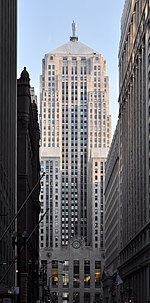Economy of Illinois

Chicago Board of Trade building
|
|
| Statistics | |
|---|---|
| GDP | $775,007 million (2015) |
|
GDP per capita
|
$60,265 (2015) |
|
Population below poverty line
|
12.2% |
| 0.469 | |
|
Labor force
|
6,488,200 (May 2015) |
| Unemployment | 6.6% (May 2016) |
| Public finances | |
| Revenues | $29,761.862 million |
| Expenses | $19,831 million |
The economy of Illinois includes many industries. The Chicago metropolitan area is home to many of the United States' largest companies, including Boeing, McDonald's, Motorola, and United Airlines. The Chicago area economy headquarters a wide variety of financial institutions, and is home to the largest futures exchange in the world, the Chicago Mercantile Exchange.
The 2015 total gross state product for Illinois was $775 million, placing it fifth in the nation. The 2013 median household income was $56,210. The state's industrial outputs include machinery, food processing, electrical equipment, chemical products, publishing, fabricated metal products, transportation equipment, petroleum and coal.
Most of the state of Illinois lies outside of the Chicago urban area and inside the North American Corn Belt. Corn, soybeans, and other large-field crops are grown extensively. These crops and their products account for much of the state's economic output outside of Chicago. Much of the field crop is remanufactured into feed for hogs and cattle. Dairy products and wheat are important secondary crops in specific segments of the state. In addition, some Illinois farmers grow specialty crops such as popcorn and pumpkins. The state is the largest producer of pumpkins among the U.S. states. There is a large watermelon growing area centered on Lincoln, Illinois. Illinois wine is a growing industry. In December 2006, the Shawnee Hills were named Illinois's first American Viticultural Area (AVA).
...
Wikipedia
